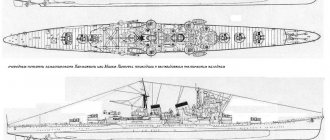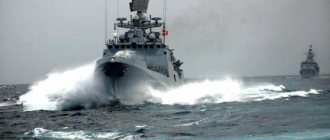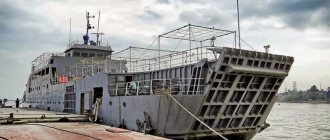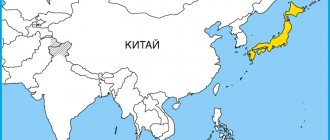The history of shipbuilding is full of various examples of achieving the most incredible records. It seems that from the very moment when ancient man thought of attaching oars to a boat, people did not get tired of improving the capabilities of the fleet, both passenger, cargo and military.
In the twentieth century, the development of shipbuilding reached unprecedented heights: then it was no longer enough to create a ship that effectively fulfilled its original purpose; it was necessary to add more and more technical delights to its capabilities.
Many shipbuilding companies tried not only to build a durable ship, but also, for example, to make it the largest representative of the same class existing at that time. This very often not only increased the efficiency of the vehicle, but perpetuated the names of its creators in history.
Introducing the 10 longest ships in the world.
The incredible USS Enterprise
Year of creation: 1960
Length - 342 m.
It is the world's largest nuclear-powered attack aircraft carrier. It is the first with a functioning nuclear propulsion system. Construction of the ship began in 1961. The developers' plans included a series of six such behemoths, but they only managed to build the Enterprise. Its cost was 451 million dollars. At that time, this was incredible money even for the US budget. This is the longest warship in the whole world. In February 2022, the ship was retired - this was the first farewell to a nuclear-powered aircraft carrier of the American fleet.
Not only on the surface: Akula class submarines
Huge and dangerous ships are found not only on the surface of the world's oceans, but also under water. We are, of course, talking about submarines. And here the unconditional primacy belongs to the Russian Navy: it is in its composition that heavy strategic missile submarines of Project 941 “Akula” serve. They were conceived and designed at the height of the Cold War as part of the USSR's nuclear triad (strategic aircraft, intercontinental ballistic missiles and nuclear-powered missile submarines) and were intended, in short, to guarantee the destruction of the enemy in World War III. Only six Sharks were built (according to the SALT I treaty), and at the end of the Cold War, five of them were withdrawn from the fleet.
There is only one left - TK-208 "Dmitry Donskoy". Like any other large warship of our time, this submarine deserves a separate material or even several, but since we are identifying here not the most powerful, but the largest ships, here are the dimensions: 172 meters long, 23.3 meters wide and 26 meters high; two nuclear reactors, a displacement of more than 48 thousand tons (submerged) and, among other things, the ability to break through ice up to 2.5 meters thick and float in the Arctic...
Soviet Rear Admiral V.G. Lebedko spoke about the “Sharks” like this: “If this boat is placed in Moscow somewhere next to the Tsar Cannon, then, looking at it, humanity will consciously and voluntarily refuse to wage any wars forever.”
...as well as a gym, a swimming pool measuring 4 by 2 m and a depth of 2 m, filled with heated fresh or salt sea water, a solarium, a sauna, and a “living corner”. And the ability to provide 160 crew members with everything they need for six months of autonomous navigation.
Mozah
Loading capacity - 128,800 tons.
Vessel length – 345 m.
This vessel is part of the Q-Max family of tankers. It was built in 2007. All ships of this type are used to transport liquefied natural gas, which is produced on the shores of Qatar. The tanker was designed and built in South Korea. Currently, only 14 tankers of this series are in operation.
Prelude
The first place went to the ship with this name. And the floating platform itself was the first in the world. People used it both for transportation and for liquefying and extracting natural gas on board. This wonderful and huge model is manufactured by Samsung Heavy Industries. Apparently, Samsung is already tired of creating phones and TVs. It's time to come up with masterpieces. Nowadays, the ship is considered the largest in the world. As for the completion of construction of all components, it will come to an end in 2017. At the same time, the company wants to drill the seabed off the coast of Australia.
Queen Mary II
Length - 345 m.
Loading capacity - 19,200 tons.
The cruise ship is one of the most incredibly large passenger ships in the entire world. It can easily and comfortably transport 2,620 people from the New to the Old World. The design and construction of the vessel was carried out in France in 2002. There is everything for comfortable movement of people: a casino, a theater, a planetarium and 15 restaurants.
Battleship Missouri (270.4 m)
Built in the mid-1940s, the USS Missouri was in service with the United States Navy for almost 50 years and during this period took part in almost every military campaign of the country, starting with the final battles of the American Navy and the Japanese Navy in 1944-1945. . and ending with the famous Operation Desert Storm in 1991.
An average of 10 thousand people took part in the creation of this grandiose vessel, which was initiated in 1941. The ship was commissioned in 1944. Then she was recognized as one of the 4 battleships of the Iowa class, which emerged at the end of World War II and were then considered one of the most advanced and powerful military ships in the world.
Allure of the Seas
The length of the ship is 362 m.
Deadweight – 19,750 tons.
A cruise ship from the Oasis class of ships was launched in 2008. This incredible giant can accommodate 6,296 passengers on board, and that's not counting the 2,384 crew members! There is a huge and varied list of entertainment on board. This is a whole floating city. There is an ice skating rink, a golf course, many bars, shops and even a park with many exotic plants.
Vale Sohar
Length: 362 m
Deadweight: 400315 t
Launched: 2012
Flag: Marshall Islands
Status: in operation
This vessel belongs to the family of the largest bulk carriers, which in turn belongs to the Brazilian mining company Vale. Designed to transport ore from Brazil to the USA. A total of 30 similar ships have already been built with deadweight varying between 380 and 400 thousand tons. Sohar is one of the ships of the family with the maximum deadweight.
Queen Mary 2 / ©Tronheim Havn
TI Class
Length – 380 m.
The vessel's carrying capacity is 441,600 tons.
The vessel, which has a double hull, at one time had the largest gross tonnage. Year of construction – 2003 In total, 4 absolutely identical ships were made: “TI Europe” - with the flag of Belgium, two “TI Oceania” and “TI Africa” - with the flag of the Marshall Islands and “TI Asia”. Already in 2010, floating terminal platforms were made from the vessels “Asia” and “Africa” for the purpose of storing and unloading petroleum products. Since then, they have been operating near one of the locations of Qatar's offshore oil depots.
Steamboat
The ships were equipped with a piston steam engine. Today they have become history and are no longer produced.
Great Eastern
Until the beginning of the 20th century, the British Leviathan or Great Eastern was called the largest ship on the sea. It was intended for long journeys to India and Africa. During the entire journey he could not replenish fuel. It had a length of 211 meters and a power of 8000 hp.
Drawing of the largest steamship Great Eastern
Emma Maersk
Loading capacity – 156,800 tons.
The length of the vessel is 397 m.
This is the very first vessel of eight identical container ships from the E-class series. They were built by a large holding of the Danish Republic, Moller-Maersk Group. On her maiden voyage in 2006, she was the world's largest floating vessel. The huge ship Emma Maersk transports various cargoes between America and Asia, passing through the Suez Canal, as well as the Strait of Gibraltar. This ship has a rather sad history of existence. When its construction was nearing completion, a fire broke out on the upper deck, which caused quite a lot of damage to the new ship. After a long-term repair, a new problem occurred in 2013: one of the ship’s power plants broke down in the middle of the Suez Canal, causing it to lose control. By a lucky chance, the ship remained intact. European countries did not like this ship for using sulfur-rich fuel.
Aircraft carrier Charles de Gaulle
Country: France Displacement: 42,000 tons (full)
The largest aircraft carrier called to replace the Clemenceau in the French Navy was the Charles de Gaulle. The ship was put into use in 2001 and is still in use today, participating in various ethnic conflicts.
The aircraft carrier is France's largest military aircraft carrier. Its length is 261 meters, the ship's crew numbers up to 1,900 people. The flagship is capable of transporting about 40 aircraft.
"Charles de Gaulle" is capable of constantly carrying up to 40 aircraft of various types: Rafale M fighters, Super Étendard attack aircraft, Grumman E-2 Hawkeye AWACS aircraft, SA-365 helicopters.
The maximum capacity of the vessel is up to 100 aircraft for up to 7 days. Starts can be made every 30 s. However, simultaneous takeoffs and landings are not provided for by the design.
It has medium and short range radar systems. Its own weapons include equipment for electronic warfare, as well as air defense systems (in particular, Aster-type anti-aircraft missiles).
The vessel supports the L16 tactical radio communications standard for data exchange between military units, in which it can act as a command post. In this case, he can control fighter aircraft, send them target designation data, and assign combat missions.
Esso Atlantic
Length – 406.5 m.
Loading capacity - 516,800 tons.
For a period of time, this oil tanker was an exceptional deadweight champion. The ship was built in Japan in 1977. The ship made its first route from African Liberia, since it was here that the owner registered it under the flag of Liberia. The tanker was often used to transport oil to Europe from the Middle East. Already in 2002, the ship was destroyed. It was dismantled for scrap in Pakistan. The ship had a “twin brother” - “Esso Pacific”. But despite such a loud Pacific name, it was much smaller than its Atlantic brother.
Kongo-class destroyer
The Japanese Navy, faced with the mission of defending the country against North Korean short- and medium-range missiles, commissioned four Kongo-class destroyers.
The ships are copies of American Burke-class guided missile destroyers. Kongo and her three sisters, Kirishima, Myoko and Chokai, are each 178 meters long and can carry a full load of 9,400 tons. Each was built with ninety of the same vertical launch silos as the Ticondero class. The Kongo class is very similar to its American ancestor, but the Japanese vehicle still has differences: a five-inch Oto-Melara cannon, LM-2500 gas turbines manufactured under license from IHI Japan, and locally produced sensors and electronics.
Kongo-class destroyers are designed to protect Japan. Equipped with the SM-3 missile interceptor. Two destroyers can protect most of the country from ballistic missiles. Two Congos are constantly at sea for this purpose.
Pierre Guillauma
Loading capacity – 556,000 tons.
The length of the ship is 414.2 m.
The largest supertanker in terms of carrying capacity from the Batillus family of twin ships was built in 1977. The ship was built in French shipyards. The ship served for only 5 years, and after that it was sent to South Korea in 1983 for processing into scrap metal. The rest of the supertankers from this family repeated the fate of their fellow. The reason for this sad end was the vessel’s obstruction through the Panama and Suez Canals.
Seawise Giant
Loading capacity - 564,700 tons.
Length – 458.5 m.
The largest ship until 2010 was the supertanker Knock Nevis, which was built in 1975 in Yokosuka, Japan. Before the ship changed several names, it had the usual number 1016. It was the incredible size that ruined the tanker. It could not pass through the Panama and Suez Canals, like many other large ships. It would have run aground even in the English Channel, so it could only be transported from ocean to ocean along a circular route. In 1988, during the Iran-Iraq War, the ship was hit by a missile and caused serious damage. As a result, the ship sank in the waters of the Persian Gulf without reaching the shore. After that, he was sent for restoration to Singapore, where in 1991 this was done. The ship received a new name "Happy Giant". But now the tanker began to serve as a floating oil storage facility. In 2009, the ship was sent to the shores of India, where it turned into a mountain of scrap metal.
The largest ships in the world
Today we will talk about the largest ships on the planet: passenger, military, cargo, industrial. Some of them are so large that they cannot pass through canals and straits, and they are closed to most ports in the world.
We have selected seven of the most amazing giant ships. Five of them have recently set sail, two have already been decommissioned, and you can even buy a ticket for one. Each of them is a champion in their category.
The longest ship on Earth
Length - 488 m, width - 74 m, deadweight - 600,000 tons. Launched in 2013.
The largest ship on the planet and the largest floating structure ever created by man is the Prelude FLING. It is equal in length to the famous Western Wall in Israel. It could accommodate five full-size football fields or 175 Olympic-size swimming pools. However, its purpose is different: it is the world's first floating factory for the extraction and liquefaction of natural gas.
The vessel is owned by the Dutch-British oil and gas company Shell, built in South Korea by Samsung Heavy Industries, and will operate off the coast of Australia, extracting gas from the ocean floor - the first drilling is planned for 2022. In the strict sense of the word, this is not exactly a ship: Prelude will not be able to sail under its own power, and will have to be towed to the workplace. But this monster is unsinkable and indestructible: it was created specifically for service in the “cyclone zone” in the open ocean and is capable of withstanding a hurricane of even the fifth, highest category. The planned service life is 25 years.
Petronas Towers with spiers
Length - 458.45 m, width - 68.86 m, deadweight - 564,763 tons. Launched in 1979, disposed of in 2010.
The largest oil tanker, Seawise Giant, was included in the Guinness Book of Records for its size. The ship is 6m longer than the 88-storey Petronas Towers in Kuala Lumpur, complete with spiers, and is approximately the width of a football field. It is so large that the draft did not allow it to pass through the Suez, Panama Canals and the English Channel.
Designed and built in Japan by Sumitomo Heavy Industries Ltd. in the mid-1970s, the tanker was intended for a Greek customer. However, he refused the purchase: during the tests, strong vibration of the hull was discovered while swimming in reverse. As a result, the ship was resold to a Hong Kong company and rebuilt: its displacement when fully loaded reached an absolute record - 657,018 tons. Over its long life, the ship changed owners and names several times, it was Happy Giant, Jahre Viking, Knock Nevis, Mont, sailed under Liberian, Norwegian, American and Sierra Leonean flags.
In 1986, Seawise Giant was nearly destroyed during the Iran-Iraq War. A missile fired by an Iraqi fighter caused a fire on board, the crew was evacuated, and the ship ran aground in the Strait of Hormuz and was considered sunk. The Norwegians found it, repaired it and sent it on a new voyage. Since 2004, the world's largest tanker has ceased to be floating and has been used as an oil storage facility near Qatar. In 2009, he made his last trip to the shores of India and was dismantled for scrap. Following the disposal of the giant, the largest supertankers are the four double-hulled TI-class ships: Oceania, Africa, Asia and Europe. They have a length of 380 m and surpass their competitors in deadweight - 441,585 tons.
Stadium running track
Length - 400 m, width - 58.6 m, deadweight - 184,605 tons, capacity - 19,100 teu (1 teu - standard 20-foot container). Launched in 2014.
In January 2015, the world's longest container ship, CSCL Globe, made its maiden voyage from China to Europe. It was built at the South Korean shipyard Hyundai Heavy Industries and is owned by the Chinese company China Shipping Container Lines. Although the ship is the largest of the container ships (it could host 400m races), it is inferior in cargo capacity to another giant: the MSC Oscar, which was also recently built in South Korea for an Italian company and can carry 124 more containers. The difference is small, but the Chinese container ship is longer and has the most powerful engine in the world: a MAN diesel engine with a capacity of 77,200 hp is hidden in the engine compartment of the vessel. With. and a height of 17.2 m. Korean shipbuilders are not going to stop there and predict the emergence of new giant container ships.
Four Statues of Liberty
Length - 382 m, width - 124 m, deadweight - 48,000 tons. Launched in 2013.
The catamaran Pioneering Spirit, which until February 2015 was called Pieter Schelte, is the absolute champion in terms of deck area. The creators claim that a small town can fit on it. The length could accommodate four Statues of Liberty (93 m with pedestal). The ship was built in South Korea according to a design by a Finnish company. Its function is to lay underwater pipelines and move drilling platforms. The ship arrived in Europe in January 2015 and has already found itself at the center of a scandal because of its name - in honor of the Nazi criminal Peter Schelte Heerm, an SS officer who was found guilty of war crimes and escaped punishment by deception. Seeing a giant ship with that name in Rotterdam, the Jewish communities of Great Britain and Holland raised an uproar, as a result of which even the British government spoke out in favor of renaming the ship. Under public pressure, the head of the Allseas company, which owns the miracle ship, and Peter Schelte’s own son, Edward Heerma, agreed not to use his father’s name in the name of the catamaran and changed it to the neutral Pioneering Spirit.
The whole city
Length - 362 m, width - 60 m, deadweight - 19,750 tons. Launched in 2009.
The largest cruise ship, Allure of the Seas, accommodates 6,296 passengers and 2,384 crew. Made in Finland by the Norwegian company STX Europe, it is owned by the American-Norwegian company Royal Caribbean International and sails between the United States and Europe. There is a whole city on board: 2,700 cabins, a park with live trees and flowers, an ice skating rink, an aquatheatre, a climbing wall, a theater for 1,380 spectators, as well as shops, bars, restaurants, baths, saunas, etc. It is noteworthy that this ship has a twin of the same class is the Oasis of the Seas cruise ship. However, Allure of the Seas is 5 cm longer. Prices for a 12-day sailing across the Atlantic from Fort Lauderdale to Barcelona start from RUB 53,600.
Six Leaning Towers of Pisa
Length - 362 m, width - 65 m, deadweight - 402,347 tons. Launched in 2010.
The largest bulk carriers for transporting ore are called Valemax: a series of ships from the Brazilian mining company Vale SA. Seven ore carriers were ordered by this company in South Korea and another 12 in China. The pioneer among the twins was the Vale Brasil, later renamed Ore Brasil: it was launched in 2010 and serves to transport ore from Brazil to Asia. This bulk carrier replaces 11,150 ore-carrying trucks, burns almost 97 tons of fuel per day and ranks second among ships in terms of deadweight, giving way to TI-class vessels. Due to its size, it can only land in some deep-water ports in Brazil, China and Europe. It could easily fit six Leaning Towers of Pisa if they were laid out lengthwise.
90 aircraft
Length - 342 m, width - 78.4 m, displacement - 94,781 tons. Commissioned in 1961, decommissioned in 2012.
The American aircraft carrier USS Enterprise (CVN-65) exceeded the length of all warships in the world, and was also the world's very first nuclear-powered aircraft carrier. The maximum capacity was 5828 people, up to 90 aircraft could be on board at the same time, but usually 60 were placed. The total ammunition ammunition was 2520 tons. Initially, it was planned to create six such aircraft, but due to the high price ($451 million) it remained the only one of its kind — its feature was not only its size, but also the presence of eight A2W type reactors.
The aircraft carrier became a symbol of US naval power and was used in almost all wars and conflicts involving this country: in the Cuban Missile Crisis, in the Vietnam War in 1965, in Iraq in 1998, in Afghanistan in 2001, in the Iraq War of the 2000s , in the fight against Somali pirates in 2011.
Over its long life, the aircraft carrier went to sea 25 times, completed one circumnavigation of the world (in 1964), set a record for the number of combat missions on board a ship (65 in one day in 1965) and almost exploded in 1969 when on board An unplanned self-launch of aerial bombs occurred, which provoked the scattering of missiles and the destruction of 15 aircraft. Then 27 people were killed, 314 people were injured, and the damage caused to the ship was estimated at $6.4 million. However, the miracle aircraft carrier was restored and continued to sail until it was decommissioned in 2012. Its complete disposal is planned for 2016.










